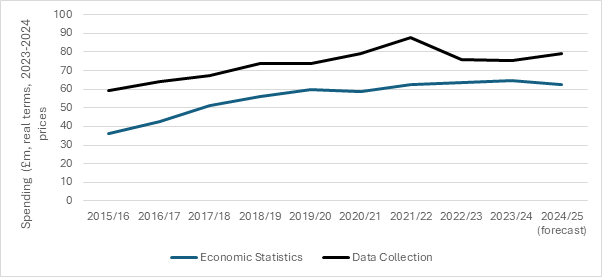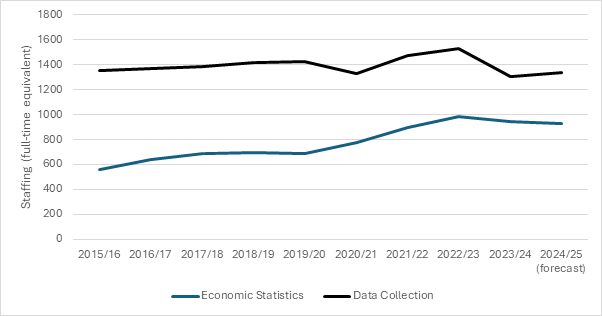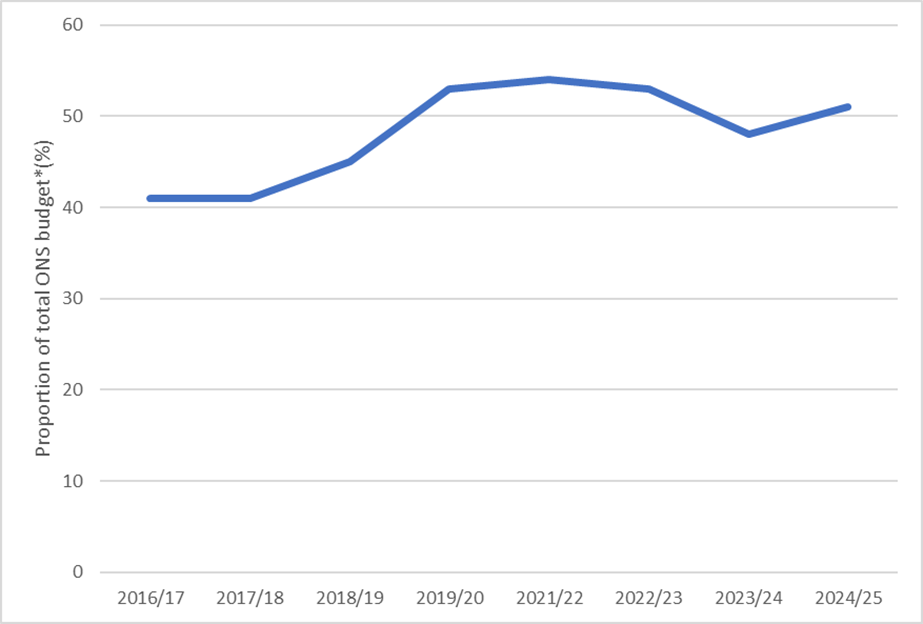Allocation of Resources to Economic Statistics
The Code of Practice for Statistics sets out a set of principles and practices that producers of official statistics should follow. These include a requirement that sufficient human, financial and technological resources should be provided to deliver statistical services that serve the public good and that good business practices should be maintained in the use of resources. To inform this review, we have sought information from ONS to help us assess how the level of resourcing for economic statistics has changed over time.
In summary, our conclusion from reviewing the evidence provided by ONS on the allocation of resources is that making sufficient resources available for its high-priority economic statistics, and particularly the survey data sources on which they are based, has been a consistent challenge:
- ONS increased the overall level of resources allocated to economic statistics following the 2016 Bean review.
- But in the context of growing demands and a changing environment, including the pandemic, in recent years ONS has found it difficult to maintain real-terms funding for the survey-based sources upon which core economic statistics depend.
- Moreover, resource pressures on economic statistics and on the ONS as a whole have intensified in the last two years.
- This resource challenge has been exacerbated by “ringfences” in ONS’s funding arrangements put in place by HM Treasury, which restrict spending to specific purposes.
Increase in the resources allocated to economic statistics
At our request, ONS provided data on expenditure and headcount (in full-time equivalent (FTE) terms) allocated to the production of economic statistics and the associated data collection (household and business surveys). We have not independently verified these data. Charts 3 and 4 illustrate these data. We have adjusted the expenditure data for inflation using the GDP implied deflator. In interpreting the data, it should be noted that in 2021/22, the Transformation Integrated Shared Services (TISS) team was moved into Surveys Directorate, including around £6m in budget and associated staffing. Support functions (for example, human resources) are excluded.
Chart 3. Economic statistics and associated data collection – expenditure (£m, real terms, 2024 prices).
Source: ONS provided data. OSR applied the GDP deflator to derive real-terms data.
Note: In 2021/22, the Transformation Integrated Shared Services (TISS) team was moved into Surveys Directorate, including c.£6m in budget.
Chart 4. Economic Statistics Development and Production and associated Data Collection – Staff numbers (FTEs).
Source: ONS provided data.
Note: In 2021/22, the Transformation Integrated Shared Services (TISS) team was moved into Surveys Directorate, including c.£6m in budget. There is also an associated increase in FTE, although ONS has not quantified this.
Overall, the real expenditure and headcount allocated to the production of economic statistics (including associated data collection) has increased, with the total headcount growing by 18% between 2015/16 and 2023/24. However, the increase in headcount has been concentrated in the collation of economic statistics rather than in data collection.
ONS notes that given the integrated nature of its operations, there will have been reliance on data operations, digital services, methodology and technical development, as well as overhead costs (for example, licensing and kit provision, support from HR, estates, finance, commercial functions, etc.) that will have supported the delivery of both economic statistics and survey data collection over time. It also highlights the difficulty in separating out such costs reliably over time. But to give a sense of scale, ONS had a gross budget of £425m in 2024/25, of which £170m is accounted for by support functions including estates, data storage and processing, IT kit, software licenses, and business support from corporate services.
Between 2016/17 and 2019/20, ONS increased the proportion of spend available for economic statistics and data collection and has taken steps to attempt to maintain this proportion since, in a challenging financial climate.
Chart 5. Proportion of total budget* allocated to economic statistics, including data collection.
Source: ONS provided data.
Note:* To aid comparison over time, total budget excludes spend on census, COVID-19 Infection Survey, ringfenced programmes (other than ARIES and PSP) and reserves.
In interpreting these trends, it should be noted that, over the period shown in the charts, ONS faced the challenges of the pandemic and initiated the Transformed Labour Force Survey, parallel-running it alongside the Labour Force Survey. In addition, ONS had to fund larger-than-anticipated pay increases in 2023/24 and 2024/25 and one-off payments in 2023/24. ONS also does not have full budget flexibility as some budgets are subject to so-called ringfences, meaning that they must be spent for the intended purpose. In 2023/24, ONS’s ringfenced budgets were £167.5 million, which amounted to 43% of the ONS budget (this includes some work where ONS recovers its costs from other income sources). In recognition of the impact of the lack of budget flexibility, HM Treasury has relaxed these ringfences from 1 April 2025.
In addition, the expenditure data (and the associated headcount) include some funding from budgets linked to specific new outputs and projects. This includes funding from the Census and Data Collection Transformation Programme (from 2015/16); the Economic Statistics Transformation Programme (from 2016/17); the Bean review (from 2017/18); the Ambitious, Radical, and Inclusive Economic Statistics programme (from 2021/22); the Integrated Service Programme (from 2021/22); the Future of Population and Migration Statistics programme (from 2023/24); and the Public Sector Productivity programme (from 2023/24). Outside of those programmes with a core economic statistics focus, ONS has highlighted that the level of expenditure and headcount deployed on these programmes within economic statistics and data collection would be minimal.
Back to topResourcing pressures have intensified over the last 2 years
Spend on data collection increased by in real terms from 2015/16 to 2021/22 (including when adjusting for the move of the TISS team in 2021/22) However, there was subsequently a fall in resources. In 2023/24, there was a fall in the number of staff in data collection. We heard from ONS staff that this decrease reflects both a reduction in the money available for data collection operations and challenges in recruiting and retaining interviewers as people faced increasing living costs. The reduction in the number of interviewers coincided with increasing challenges in achieving interview responses. Insufficient investment, alongside the parallel need to transform surveys, is a key factor in the data quality issues that have subsequently emerged.
Resource allocation to economic statistics increased by 65% in real terms from 2015/16 and 2019/20. After this period resources have increased by 28% nominal terms, but has been broadly flat in real terms. The increases to 2019/20 reflect allocation to economic statistics following the Bean review (including the establishment of the ESCoE and Data Science Campus) and allocation to transformation projects for economic statistics. In 2023/24, costs for the ESCoE were £1.36m and for the Data Science Campus £6.7m.
ONS allocated much of the additional resources following the Bean Review to new activity, recognising the need to innovate to ensure its statistics evolve to measure the changing economy and to use new data sources and methods. The primary focus was on innovation rather than additional money for delivery of existing economic statistics, although innovation in sources and methods would be expected in time to lead to efficiency savings that would free up resources that could be used to support core outputs.
ONS staff members have highlighted that, as budgets became tighter due to the wider fiscal context, statistical production areas had to make cost savings and efficiencies alongside both running the additional statistical production stemming from the transformation programmes and responding to the COVID-19 pandemic. We also see evidence in our regulatory work of resource challenges, including most recently in trade statistics. In this context, producing core statistics has become increasingly challenging, with many areas carrying funded vacancies. ONS has recognised this challenge in recent business planning rounds, placing a focus on protecting funding for core statistics.
Back to top



